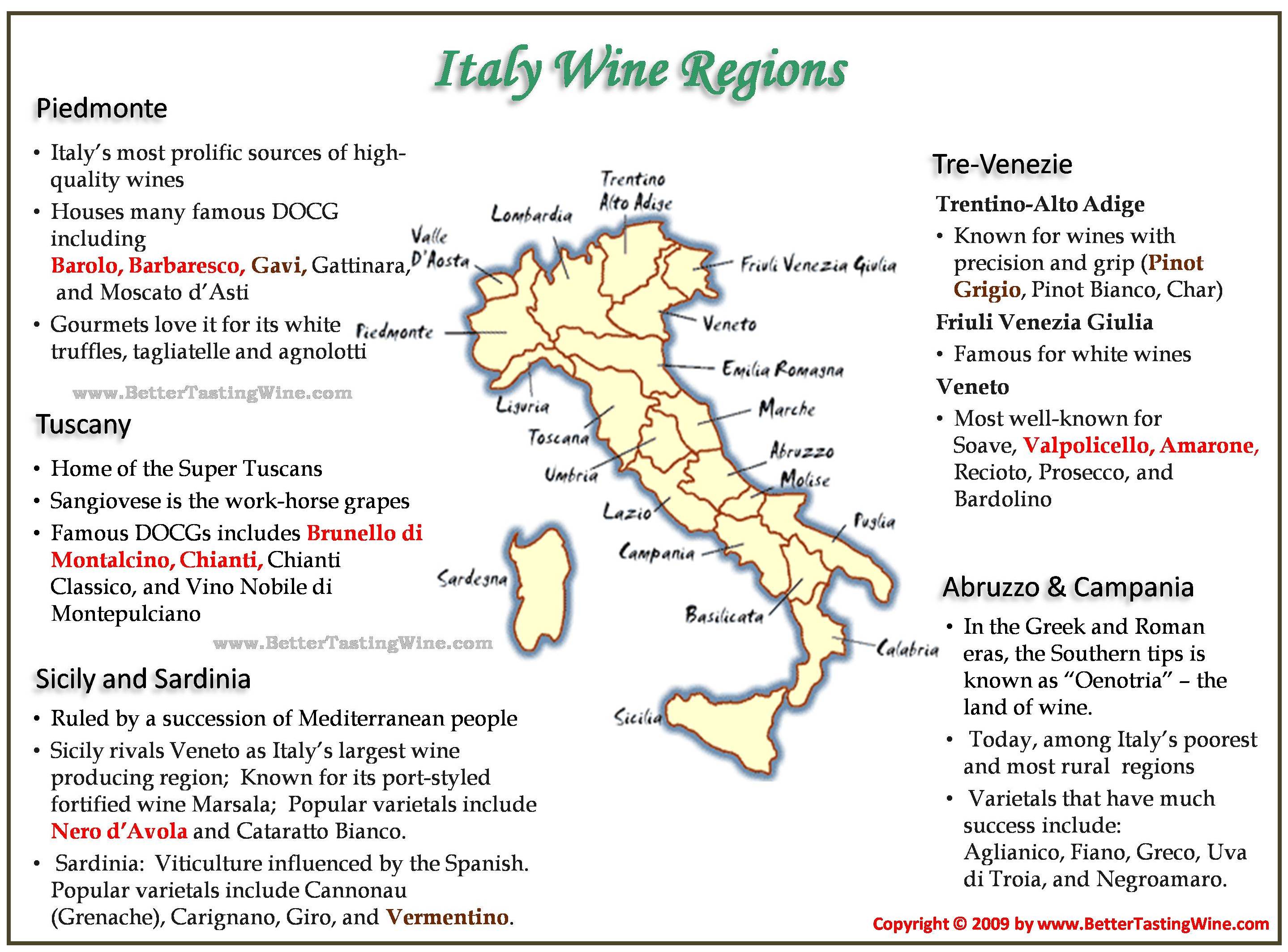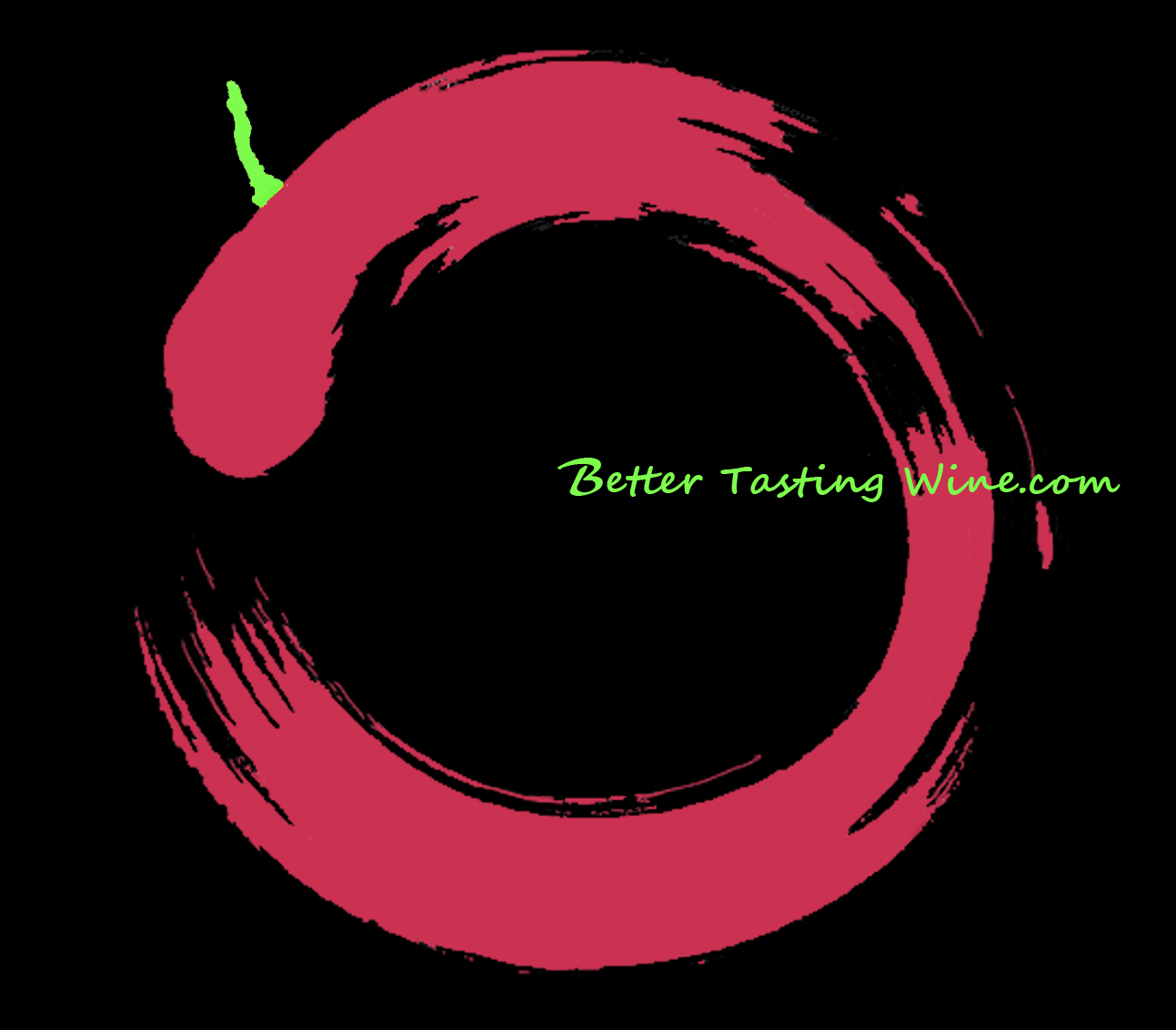|
|
Being the most diverse wine producing country, Italy has thousands of wine varieties and over 300 DOGs. We will focus on the three key regions: Piedmont in the northwest, Veneto in the northeast, and central Tuscany. We will also take a quick look at Southern Italy. Just like Southern France, it is a region with potential.
Interactive Italy Wine Map: Click on the text for a specific region.

Appellation Classifications
Similar to France's, Italy classifies wine into 4 levels of quality:
- Vino da Tavola (Table Wine): This is the lowest quality category. Minimal (or no) regulation is imposed. For example, vintage date is not required. Also, there can be no association to region.
- Indicazione Geografica Tipica (IGT): This category was created to include quality wine produced in a DOC region but does not comply with its criteria. For example, SuperTuscans (Sangiovese blended with Cabernet Sauvignon) would fall under this category.
- Denominazione D'Origine Controllata (DOC): Wine subjects to rigid regional regulations on grape variety, yields per hectare, aging requirement, and vinification methods.
- Denominazione D'Origine Controllata E Garantita (DOCG): A category for the most prestigious subregions in the DOC. Distinctive style, appellation reputation, and commercial success are the additional criteria.
Italian classification system has gone through rounds of improvement. Compared to France where one-third of the wine produced falls into the AOC category, only 14% of Italian wine is qualified DOC/DOCG. There are 300 DOCs and ~32 DOCGs. The majority (over 75%) of Italian wine falls in the vino da tavola category.
Useful Wine Label Knowledge
Good to know when reading Italian wine labels:
- DOC and DOCG wines can be named in several ways:
- By appellation: for example Barolo or Brunello di Montalcino.
- By varietal plus the region of origin: e.g. Nebbiolo d'Alba.
- By color (for blends) plus the region of origin: e.g. Rossi di Montalcino is made from a blends of red grapes from Montalcino
- Classico generally indicates a more prestigious sub-region. Valpolicella Classico, for instance, is the region known for superior Valpolicella. Similar for Soave Classico.
- Riserva and Superiore do not assure quality. Riserva implies additional aging and superiore means higher alcohol level. Given that Italy has 300 DOCs, these words are informative but definitely not indicative on the quality of wine.
Piedmont
Piedmont is the most well-known Italian wine region, housing the esteemed (and expensive) Barolo and Barbaresco sub-regions. It is also the home of the Nebbiolo, Barbera, and Dolcetto grapes.
Nebbiolo based wines such as Barolo and Barbaresco are intense, tannic, and complex. Highly tannic, these wines benefit from long aging and are best accompanied by food. Despite coming from the same grape, terroir and local traditions have given each an unique style. Barolo is more intense, reminiscent of tar. Barbaresco is plummier and more fruity.
Barbera, compared to Nebbiolo, is lighter, less tannic and more acidic. It is the most planted grape in Piedmont, making variety of wine (light to dense, still to sparkling). Alba, Asti, and Monferrato are three subregions in Piedmont well-known for it.
Dolcetto is another common grape in the region. Though it literally means sweet little thing, Dolcetto is dry. It is lighter, velvety in texture, less tannic, and fruitier than Nebbiolo and Barbera. Alba, Acqui, and Asti are three regions who lend their name to Dolcetto (e.g. Dolcetto d'Abla, Dolcetto d'Acqui, and Dolcetto d'Asti).
Despite its overshadowing reds, Piedmont also has three famous whites:
- The sparkling Asti Spumante is one of the most exported Italian wines.
- Cortese di Gavi, a dry, crisp, lean white made from the Cortese Grape -- is described by Hugh Johnson (a renowned wine writer) as "Italy's most prestigious white wine."
- Arneis di Roero challenges France's Pinot Blanc with its highly aromatic, almondy flavor.
Return to Top of Page
Tuscany
Tuscany is one of the first wine regions in Europe. It is also one of Italy's top wine producing regions (after Piedmont). Despite producing many wine varieties, Tuscany is best known for: Chianti, Brunello di Montalcino, Vino Nobile de Montepulciano, and Carmignano. The table below describes their principal grape varietals and style.
| Region / Wine |
Principal Grapes |
Style |
| Chianti |
Sangiovese (blend with up to 7 other grapes) |
Full-bodied red, slight bitter twist, hints of licorice. |
| Brunello di Montalcino |
100% Sangiovese |
Rich, strong backbone, complex, best with aging. |
| Vino Nobile di Montepulciano |
Sangiovese (blend with 3 others) |
Softer and easier to drink than Brunello di Montalcino. |
| Carmignano |
Sangiovese (blend with Cabernet Sauvignon) |
Full-bodied, complex, less acidic than Chianti. |
Chianti is also the region where most Super Tuscans are produced. SuperTuscans are the untraditional Italian wines that use Cabernet Sauvignon as a blend. The IGT classification was created to recognize their quality.
Return to Top of Page
Tre Venezia
Tre Venezia is the collective name given to the three wine regions near the city of Venice: Friuli-Venezia Giulia, Trentino-Alto Adige, and Veneto.
Veneto is the largest subregion in the northeast.
Veneto Wine and Grapes
| Soave |
A light, simple white wine made from Garganega and Trebbiano. |
| Bardolino |
A light red made from Corvina, Rondinella, and Molinara. |
| Valpolicella |
A light red made from Corvina (blended with Molinara and Rondinella) |
| Amarone |
Intense, full-bodied, aromatic red made from Corvina. |
| Prosecco |
Sparkling, semi-sweet wine made from the grape Prosecco. |
Trentino-Alto Adige produces various grapes. The DOC of Alto Adige allows as many as 19 varietals. Alto Adige, Santa Maddelena, Trentino, and Rotaliano are the more commonly exported wines from this region. Wine is usually named by varietals. Schiava is the predominant red. Teroldego Rotaliano (made from the native grape Teroldego) is considered one of the best wines from this region.
Fiuli-Venezia Giulia is better known for its white than red wines. Pinot Grigio, Sauvignon Blanc, and Pinot Bianco are grown, though the region is most proud of Tocai -- its native grape. Like Trentino-Alto Adige, wine is usually named by varietals.
Return to Top of Page
Southern Italy
Once preceived as a region that produces cheap and mediocre wines. Southern Italy has gone through a lot of changes with many quality producers and up-and-coming wines. Some good DOCG/DOC and good bargain wines:
- Salice Salentino: Full-bodied, fruity red made from regional grape Negroamaro.
- Taurasi: Known as the Barolo of the South, a full-bodied red made from regional grape Aglianico.
- Vermentino di Sardegna: a dry white made from grape Vermentino.
Return to Wine Regions | Proceed to Spain |

